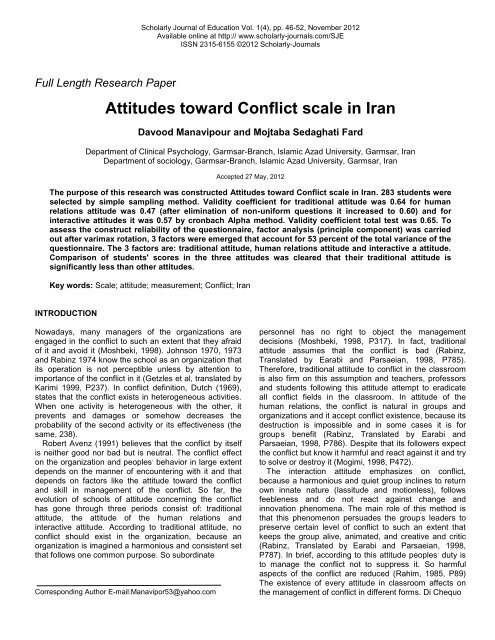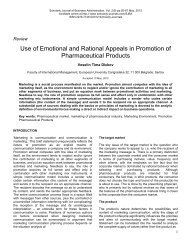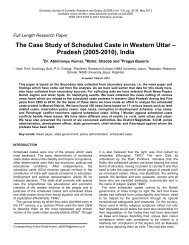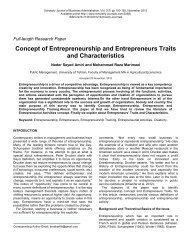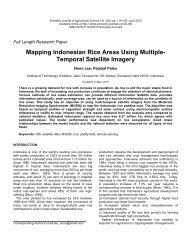Full Article - PDF - Scholarly Journals
Full Article - PDF - Scholarly Journals
Full Article - PDF - Scholarly Journals
You also want an ePaper? Increase the reach of your titles
YUMPU automatically turns print PDFs into web optimized ePapers that Google loves.
<strong>Scholarly</strong> Journal of Education Vol. 1(4), pp. 46-52, November 2012<br />
Available online at http:// www.scholarly-journals.com/SJE<br />
ISSN 2315-6155 ©2012 <strong>Scholarly</strong>-<strong>Journals</strong><br />
<strong>Full</strong> Length Research Paper<br />
Attitudes toward Conflict scale in Iran<br />
Davood Manavipour and Mojtaba Sedaghati Fard<br />
Department of Clinical Psychology, Garmsar-Branch, Islamic Azad University, Garmsar, Iran<br />
Department of sociology, Garmsar-Branch, Islamic Azad University, Garmsar, Iran<br />
Accepted 27 May, 2012<br />
The purpose of this research was constructed Attitudes toward Conflict scale in Iran. 283 students were<br />
selected by simple sampling method. Validity coefficient for traditional attitude was 0.64 for human<br />
relations attitude was 0.47 (after elimination of non-uniform questions it increased to 0.60) and for<br />
interactive attitudes it was 0.57 by cronbach Alpha method. Validity coefficient total test was 0.65. To<br />
assess the construct reliability of the questionnaire, factor analysis (principle component) was carried<br />
out after varimax rotation, 3 factors were emerged that account for 53 percent of the total variance of the<br />
questionnaire. The 3 factors are: traditional attitude, human relations attitude and interactive a attitude.<br />
Comparison of students' scores in the three attitudes was cleared that their traditional attitude is<br />
significantly less than other attitudes.<br />
Key words: Scale; attitude; measurement; Conflict; Iran<br />
INTRODUCTION<br />
Nowadays, many managers of the organizations are<br />
engaged in the conflict to such an extent that they afraid<br />
of it and avoid it (Moshbeki, 1998). Johnson 1970, 1973<br />
and Rabinz 1974 know the school as an organization that<br />
its operation is not perceptible unless by attention to<br />
importance of the conflict in it (Getzles et al, translated by<br />
Karimi 1999, P237). In conflict definition, Dutch (1969),<br />
states that the conflict exists in heterogeneous activities.<br />
When one activity is heterogeneous with the other, it<br />
prevents and damages or somehow decreases the<br />
probability of the second activity or its effectiveness (the<br />
same, 238).<br />
Robert Avenz (1991) believes that the conflict by itself<br />
is neither good nor bad but is neutral. The conflict effect<br />
on the organization and peoples , behavior in large extent<br />
depends on the manner of encountering with it and that<br />
depends on factors like the attitude toward the conflict<br />
and skill in management of the conflict. So far, the<br />
evolution of schools of attitude concerning the conflict<br />
has gone through three periods consist of: traditional<br />
attitude, the attitude of the human relations and<br />
interactive attitude. According to traditional attitude, no<br />
conflict should exist in the organization, because an<br />
organization is imagined a harmonious and consistent set<br />
that follows one common purpose. So subordinate<br />
Corresponding Author E-mail:Manavipor53@yahoo.com<br />
personnel has no right to object the management<br />
decisions (Moshbeki, 1998, P317). In fact, traditional<br />
attitude assumes that the conflict is bad (Rabinz,<br />
Translated by Earabi and Parsaeian, 1998, P785).<br />
Therefore, traditional attitude to conflict in the classroom<br />
is also firm on this assumption and teachers, professors<br />
and students following this attitude attempt to eradicate<br />
all conflict fields in the classroom. In attitude of the<br />
human relations, the conflict is natural in groups and<br />
organizations and it accept conflict existence, because its<br />
destruction is impossible and in some cases it is for<br />
group ' s benefit (Rabinz, Translated by Earabi and<br />
Parsaeian, 1998, P786). Despite that its followers expect<br />
the conflict but know it harmful and react against it and try<br />
to solve or destroy it (Mogimi, 1998, P472).<br />
The interaction attitude emphasizes on conflict,<br />
because a harmonious and quiet group inclines to return<br />
own innate nature (lassitude and motionless), follows<br />
feebleness and do not react against change and<br />
innovation phenomena. The main role of this method is<br />
that this phenomenon persuades the group ' s leaders to<br />
preserve certain level of conflict to such an extent that<br />
keeps the group alive, animated, and creative and critic<br />
(Rabinz, Translated by Earabi and Parsaeian, 1998,<br />
P787). In brief, according to this attitude peoples , duty is<br />
to manage the conflict not to suppress it. So harmful<br />
aspects of the conflict are reduced (Rahim, 1985, P89)<br />
The existence of every attitude in classroom affects on<br />
the management of conflict in different forms. Di Chequo
Manavipour and Fard 47<br />
Table 1. Alpha for 5 traditional attitudes<br />
Alpha if Item Deleted<br />
0.58<br />
0.69<br />
0.61<br />
0.55<br />
0.48<br />
Item-Total Correlation<br />
0.41<br />
0.17<br />
0.39<br />
0.47<br />
0.62<br />
0.64<br />
Corrected Variance<br />
if Item Deleted<br />
8.95<br />
10.3<br />
8.74<br />
8.4<br />
8.01<br />
Scale Mean if Item<br />
Deleted<br />
11.91<br />
12.87<br />
12.07<br />
12.31<br />
12.27<br />
Questions<br />
1<br />
4<br />
7<br />
10<br />
13<br />
Alpha<br />
Table 2. Alpha for 5 attitudes of the human relations<br />
Alpha if Item<br />
Deleted<br />
0.41<br />
0.29<br />
0.34<br />
0.6<br />
0.34<br />
Item-Total<br />
Correlation<br />
0.25<br />
0.47<br />
0.33<br />
-0.05<br />
0.34<br />
Corrected Variance if Item<br />
Deleted<br />
7.05<br />
6.69<br />
5.62<br />
8.66<br />
6.55<br />
0.47<br />
Scale Mean if Item<br />
deleted<br />
13.78<br />
13.53<br />
14.31<br />
14.76<br />
13.65<br />
Questions<br />
2<br />
5<br />
8<br />
11<br />
14<br />
Alpha<br />
and Richards (1974) have investigated about 8500<br />
students of the prime and last year of high school in<br />
Newyork,Filadelphia and Sanfransisco. They understood<br />
that either schools personnel or students are avoiding<br />
expressing obvious anger and debate about conflicts.<br />
Also they reported 61% students imagine negative the<br />
outcomes of conflicts and only 9% of them know conflict<br />
as a positive outcome. In 91% of conflicts, the students<br />
state that the conflict management has not lowered the<br />
tension (Getzles et al, Translated by Karimi, 1999, P239).<br />
In a research, has made a questionnaire to study the<br />
attitude of schools , managers toward conflict. He has<br />
computed the content admissibility of the questionnaire<br />
using specialists , opinions and its stability or credibility<br />
calculated by cronbakh Alpha. The credibility coefficient<br />
for traditional attitude, the attitude of the human relations<br />
and interaction attitude has been reported 0.85, 0.51,<br />
0.62 respectively (also the present research has been<br />
provided for students using Soleimani , s questionnaire<br />
and doing changes in it).<br />
Rahim (1983) has made the questionnaire with 15<br />
questions to measure solving methods of interpersonal<br />
conflict (this questionnaire is present in Rabinz , s book<br />
[1998] with the title of organizational behavior). The<br />
content admissibility of this questionnaire has been<br />
studied using specialists , opinions (Rahim, 1983, Rabinz,<br />
1998) and its credibility has been estimated by Soleimani<br />
as following: Competition 0.59, cooperation 0.46,<br />
avoidance 0.45, adaptation0.83 and compromise 0.40.<br />
The present research aims to make a measurement<br />
scale of students , attitude toward conflict and the<br />
research main question is: Does this questionnaire<br />
possess suitable admissibility and credibility among<br />
students , society?<br />
METHOD<br />
This research is an expansion-psychometrics plan. The<br />
statistical society includes all students of educative<br />
sciences in Garmsar and Islamshahr units of Islamic<br />
Azad University in first semester of academic year 2010-<br />
2011 by using available sampling. One class is<br />
considered from every university unit and all students of<br />
two classes answered questions.<br />
RESULT<br />
In the basis of the conflict literature in human behavior<br />
and social psychology of the education, suitable choices<br />
were provided in preliminary stage of questionnaire<br />
making by emphasizing on the evolution of conflict<br />
proposed by Rabinz in the book of organizational<br />
behavior and using questionnaire. These choices have<br />
been provided according to the conditions of students ,<br />
classrooms and three attitudes of traditional, the human<br />
relations and interaction toward conflict.<br />
The questions related to every attitude are determined<br />
and marked by Likert , s rating. The choices consist of<br />
perfectly agree, agree, disagree, perfectly disagree and<br />
no idea. All questions are marked as 1, 2,3,4,5 with<br />
respect to choices. So high score in questions of every<br />
attitude is indicative of subject ' s dominant attitude, the<br />
questions related to the attitudes consist of: traditional<br />
attitude 13-10-7-4-1, the attitude of the human relations<br />
14-11-8-5-2 and the interactive attitude 15-12-9-6-3(the<br />
example of the questionnaire was given in Appendix 1).<br />
The content admissibility of primary questionnaire was<br />
studied using polling of psychology professors. Then the
<strong>Scholarly</strong> J. Educ. 48<br />
Table 3. Alpha for 4 attitudes of the human relations after delete q 11<br />
Alpha if Item Deleted<br />
0.63<br />
0.43<br />
0.59<br />
0.47<br />
Item-Total<br />
Correlation<br />
0.24<br />
0.57<br />
0.34<br />
0.46<br />
0.60<br />
Corrected Variance if Item<br />
Deleted<br />
6.32<br />
5.61<br />
4.85<br />
5.29<br />
Scale Mean if Item<br />
Deleted<br />
11.04<br />
10.78<br />
11.57<br />
10.9<br />
questions<br />
2<br />
5<br />
8<br />
14<br />
Alpha<br />
Table 4. Alpha for 5 interactive attitudes<br />
Alpha if Item Deleted<br />
0.43<br />
0.57<br />
0.58<br />
0.49<br />
0.50<br />
Item- Total Correlation<br />
0.49<br />
0.25<br />
0.20<br />
0.38<br />
0.36<br />
0.57<br />
Corrected Variance if Item<br />
Deleted<br />
10.38<br />
10.9<br />
12.69<br />
10.13<br />
10.55<br />
Scale Mean if<br />
Item Deleted<br />
13.5<br />
14.31<br />
13.69<br />
14<br />
13.5<br />
questions<br />
3<br />
6<br />
9<br />
12<br />
15<br />
Alpha<br />
Table 5. Alpha for 15 questions (total)<br />
Alpha if Item Deleted<br />
0.63<br />
0.62<br />
0.63<br />
0.65<br />
0.60<br />
0.64<br />
0.67<br />
0.61<br />
0.63<br />
0.65<br />
0.64<br />
0.62<br />
0.64<br />
0.62<br />
0.61<br />
Item- Total correlation<br />
0.31<br />
0.35<br />
0.29<br />
0.09<br />
0.60<br />
0.23<br />
0.05<br />
0.37<br />
0.25<br />
0.13<br />
0.21<br />
0.31<br />
0.23<br />
0.34<br />
0.37<br />
0.65<br />
Corrected Variance if Item<br />
Deleted<br />
46.52<br />
46.05<br />
46.28<br />
49.78<br />
45.23<br />
45.69<br />
50.96<br />
44.14<br />
47.30<br />
48.95<br />
47.80<br />
44.61<br />
47.86<br />
45.96<br />
44.11<br />
Scale Mean if<br />
Item Deleted<br />
46.63<br />
46.37<br />
46.23<br />
47.51<br />
46.04<br />
47.21<br />
46.21<br />
46.84<br />
46.53<br />
47<br />
47.35<br />
46.91<br />
47<br />
46.25<br />
46.28<br />
questions<br />
1<br />
2<br />
3<br />
4<br />
5<br />
6<br />
7<br />
8<br />
9<br />
10<br />
11<br />
12<br />
13<br />
14<br />
15<br />
Alpha<br />
questionnaire was performed on 52 students. Alpha was<br />
used to study internal similarity of questions related to<br />
every attitude. The credibility attitude for traditional<br />
attitude, the attitude of the human relations and<br />
interactive attitude was 0.64, 0.47 and 0.57 respectively.<br />
With regard to the attitude of the human relations,<br />
because the correlation coefficient of the question<br />
number 11 was -0.055, this question was omitted and<br />
alpha was computed again, so the coefficient was 0.60.<br />
The reliability coefficient of total test was computed 0.65.<br />
The computed credibility coefficients are indicative of<br />
suitability of the questionnaire for research purposes. To<br />
study the admissibility of the questionnaire, factor<br />
analysis was used to examine the admissibility of the<br />
factor in addition to specialists , polling about the content<br />
admissibility.<br />
The factor analysis of the questionnaire<br />
To do factor analysis, first KMO and Bartlett tests were<br />
performed to examine suitability and qualification of data<br />
for factor analysis. According to computed values in the<br />
above tests the efficiency of suitable sample was<br />
recognized and with confidence 99% the correlation<br />
matrix of the articles has meaningful information. So<br />
there are minimum conditions to use factor analysis. The<br />
factor analysis of data was done in the way of main<br />
components with varimax type after orthogonal rotation.
Eigenvalue<br />
Manavipour and Fard 49<br />
Table 6. KMO and Bartlett tests<br />
Kaiser-Meyer-Olkin Measure of Sampling Adequacy. 0.875<br />
Approx. Chi-Square 217.154<br />
df 105<br />
. Sig<br />
0.000<br />
4<br />
Scree Plot<br />
3<br />
2<br />
1<br />
0<br />
1<br />
2<br />
3<br />
4<br />
5<br />
6<br />
7<br />
8<br />
9<br />
10<br />
11<br />
12<br />
13<br />
14<br />
15<br />
Component Number<br />
Chart 1-Scree Plot<br />
The amount of total variance of attitude toward conflict by<br />
this questionnaire is 52.131 that by using three factors<br />
with Eigen values (the squares , sum of factorial<br />
coefficients of existing articles in every factor) the factors<br />
are determined (chart1).<br />
Considering three main factors by questionnaire the<br />
amount of total variance has been determined in table 7.<br />
As shown in chart 1 and table 7, there are three factors<br />
with eigen value more than one in the questionnaire that<br />
represent most attitude toward conflict in the class. This<br />
finding is harmonious with theoretical bases of<br />
questionnaire making and indicates the admissibility of its<br />
factor. The questions related to every factor are<br />
determined in the basis of correlation matrix. To study<br />
every question correlation with every factor, the<br />
correlation coefficients more than 0.3 have been<br />
specified in following matrix (table 8).<br />
Table 8 shows the correlation coefficients between<br />
every factor and questions before access to best factorial<br />
structure. But to access for best factorial structure<br />
orthogonal rotation with varimax type was performed after<br />
four times rotation (chart2) and table 9 shows correlation<br />
coefficients of every factor with every question. The<br />
correlation coefficients in tables 8 and 9 indicate that after<br />
factors , rotation the negative correlation coefficients have<br />
been destroyed and the simplest factorial structure is<br />
attained. The chart 2 shows the structure of final factor<br />
(after rotation) that has collected the questions related to<br />
every factor in one component.<br />
The identified factors in factor analysis and correlation<br />
coefficients between factors and questions show more<br />
standardization with substructure logic of the questions in<br />
every dimension of the attitude. So the first factor is<br />
harmonious with traditional attitude, the second with the<br />
attitude of the human relations and the third is concordant<br />
with interactive attitude and these factors are named in<br />
basis of those theoretical bases. After questionnaire<br />
making and studying its admissibility and credibility for<br />
studying the spread of three attitudes among students a<br />
comparison was done using analysis of variance that<br />
table 10 shows the results.<br />
According to the value F and meaningful level 0.006,<br />
there is meaningful statistical difference with confidence<br />
99% between students , scores in three types of attitudes<br />
about the conflict. The post hoc test of Turkey was used<br />
to identify the order of this difference in three attitudes.<br />
The results of this test showed this difference between<br />
two attitudes of the human relations and interaction with<br />
traditional attitude and most students possessing these<br />
two attitudes (the human relations and interaction) and
<strong>Scholarly</strong> J. Educ. 50<br />
Table 7. Total Variance Explained<br />
Component<br />
1<br />
2<br />
3<br />
Total<br />
3.781<br />
2.580<br />
1.458<br />
Initial Eigenvalues<br />
of Variance %<br />
25.208<br />
17.202<br />
9.721<br />
Cumulative %<br />
25.208<br />
42.410<br />
52.131<br />
Table 8. Component Matrix<br />
1<br />
2<br />
3<br />
4<br />
5<br />
6<br />
7<br />
8<br />
9<br />
10<br />
11<br />
12<br />
13<br />
14<br />
15<br />
1<br />
-<br />
0.356<br />
0.777<br />
-<br />
0.678<br />
0.466<br />
-0.495<br />
0.466<br />
0.502<br />
-0.454<br />
-0.405<br />
0.395<br />
-0.403<br />
0.741<br />
0.615<br />
Component<br />
2<br />
0.624<br />
0.412<br />
-<br />
0.304<br />
0.463<br />
-<br />
0.425<br />
-<br />
-<br />
0.594<br />
0.667<br />
-<br />
0.665<br />
-<br />
-<br />
3<br />
0.477<br />
-0.327<br />
-0.407<br />
-<br />
-<br />
-<br />
-<br />
0.434<br />
0.452<br />
-<br />
-<br />
0.380<br />
-<br />
-<br />
-0.531<br />
Table 9. Rotated Component Matrix<br />
1<br />
2<br />
3<br />
4<br />
5<br />
6<br />
7<br />
8<br />
9<br />
10<br />
11<br />
12<br />
13<br />
14<br />
15<br />
1<br />
0.620<br />
-<br />
-<br />
0.333<br />
-<br />
-<br />
0.612<br />
-<br />
-<br />
0.739<br />
0.780<br />
-<br />
0.778<br />
-<br />
-<br />
Component<br />
2<br />
-<br />
0.595<br />
0.804<br />
-<br />
0.705<br />
-<br />
-<br />
-<br />
-<br />
-<br />
-<br />
-<br />
-<br />
0.401<br />
0.848<br />
3<br />
0.439<br />
-<br />
-<br />
-<br />
0.445<br />
0.509<br />
-0.310<br />
0.626<br />
0.688<br />
-<br />
-<br />
0.603<br />
-<br />
0.587<br />
-<br />
traditional attitude is meaningfully lesser among students.<br />
CONCLUSION<br />
This research aimed to make a questionnaire for<br />
measuring students , attitude toward conflict. This<br />
research ' s results indicate that three attitudes of<br />
traditional, the human relations and interaction toward the<br />
conflict can be measured using this questionnaire. The<br />
admissibility and credibility of this questionnaire is to such<br />
an extent that conforms its use in different researches.<br />
The results of this research are in accordance with the<br />
findings of other research. Therefore, this questionnaire<br />
is used to identify students , attitude toward the conflict<br />
that has important share in conflict management in the
Manavipour and Fard 51<br />
Chart 2. Component plot<br />
Table 10. ANOVA<br />
Between<br />
Groups<br />
Within Groups<br />
Sum of Squares<br />
129.500<br />
1894.058<br />
df<br />
2<br />
153<br />
Mean Square<br />
64.750<br />
12.379<br />
F<br />
5.230<br />
.Sig<br />
0.006<br />
Total<br />
2023.558<br />
155<br />
-<br />
class and school and as a factor in dynamism and<br />
innovation of the class. Another finding of this research is<br />
students , tendency toward the attitudes of the human<br />
relations and interaction which is more than traditional<br />
attitude. But there is no meaningful difference between<br />
their scores in these attitudes (the human relations and<br />
the interaction). This finding indicates there is a suitable<br />
chance for enjoyment and proper conflict management<br />
among students and classes and high educational<br />
system should benefit it. In this respect, the education of<br />
the conflict management to professors has effective role<br />
in dynamisms and scientific innovations in the classes. In<br />
the hope that researchers could eradicate the defects of<br />
this research and evolve it.<br />
Acknowledgements<br />
The authors appreciate the assistance of the many<br />
students involved in the studies.<br />
REFERENCES<br />
Anastazi .(2000) psychometry. translator,Mohammad Naghi Barahani.<br />
Tehran:Tehran university press.(original publication date?)<br />
Openham, AN (1990) questionnaire plan and outlook testing. translator,<br />
Marziyeh Karimniya.Tehran: Astan Ghods Razavi press.( original<br />
press date?)<br />
Best, J (1995).research methods in educational and behavioral<br />
sciences. Translator Hassan Pasha Sharifi and Narges<br />
Taleghani.Tehran:Roshd press.(original publication 1983)<br />
Delavar, A (1996).probability and applicable statistics in educational<br />
science and psychology.Tehran:Roshd press.<br />
Delavar, A (1996) research method in educational science and<br />
psychology.Tehran:Virayesh press.<br />
RAbinz, E (1994).organizational behavior essentials .translator Ghasem<br />
KAbiri.Tehran:scientific press center of Islamic Azad<br />
University.(original publication date?).<br />
Rabinz, E (1994). organizational behavior management, individual<br />
behavior.translator, Ali Parsaiyan:Mohammad Erabi.Tehran:<br />
commercial research and study institute press .first vol, .(original<br />
publication date?).<br />
Rabinz, E (1995). Organizational behavior management, group<br />
behavior. translator Ali Parsaiyan:Mohammad Erabi.Tehran:<br />
commercial research and study institute press .first vol, .(original<br />
publication date?).
<strong>Scholarly</strong> J. Educ. 52<br />
Rabinz, E (1994). Organizational behavior, Group. translator, Ali<br />
Parsaiyan:Mohammad Erabi.Tehran: cultural research office .first vol,<br />
.(original publication date?).<br />
Rafipour, F (1993) investigations and assumptions. Tehran, company of<br />
publication.<br />
Sarmad, Z (1997) research methods in behavioral<br />
sciences.Tehran:Agah press<br />
Seif, A (2003).educational measuring and evaluation methods<br />
.Tehran:Doran press.<br />
Sharifi, H (1996).psychometric and psychotesting principles<br />
.Tehran:Roshd press.<br />
Getzelz, JW (1999) social psychology of education.translator Yusef<br />
Karimi.Tehran: Virayesh press.<br />
Moshbeki, A (1998).organizational behavior<br />
management.Tehran,Termeh press.<br />
Mogimi, SM (1999).organization and management.Tehran:Tarmeh<br />
press.<br />
Manavipour, D (2003).practicable manual SPSS, computer usage in<br />
behavioral science researches. Tehran:Doevin press.<br />
Manavipour, D, Pirkhaefi, A (2005).research methods of behavior<br />
sciences. Tehran: Doevin press<br />
Michail, TR (1994) people in organizations. Translator, Hossein<br />
Shekarkan Tehran: Roshd press.<br />
Owenes, R )1991(. organizational behavior in education. forth edition.<br />
newyork allyn and bacon<br />
Rahim, A )1985 (. a strategy for managing conflict in complex<br />
organization.J of Humen relations vol . 39.<br />
Rahim, A )1983 (. a measure of styles of handling interpersonal conflict.<br />
Acad. Manage. J.<br />
Sheriff, M )1956 (. Organizational psychology. Englewood cliffs n.j<br />
prentice hal.
Appendix 1<br />
How much do you agree with following sentences?<br />
Perfectly agree, agree no idea, disagree, and perfectly disagree<br />
The conflict is harmful for university classes.<br />
The existing of the conflict is natural between university professors.<br />
The conflict in classes is indicative of dynamism and creativeness.<br />
The conflict is an individual and group defect.<br />
The professors and students should accept the conflict in the class.<br />
To create the conflict in the class is one of the professors , duty.<br />
The conflicts should be eradicated in the class.<br />
It is impossible to eradicate conflict in the class.<br />
The university classes should possess the medium level of the conflict.<br />
The university classes should be devoid of the conflict.<br />
The conflict is not chiefly useful.<br />
The existing of the conflict in the class is unavoidable.<br />
The conflict should be avoided.<br />
The conflict is a phenomenon expected in the classes.<br />
The conflict is necessary to access scientific purposes of the university.


